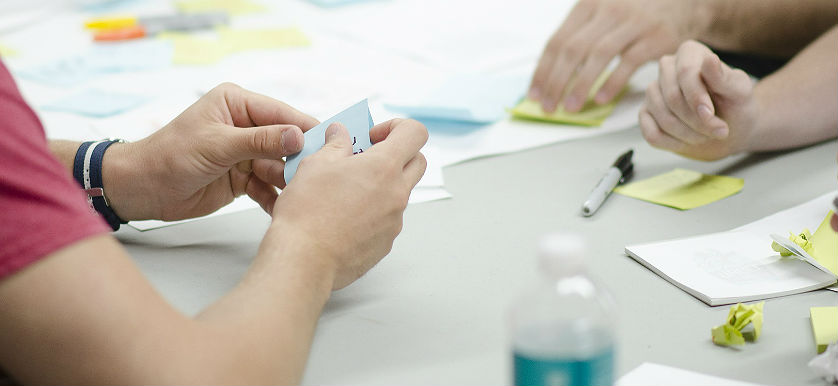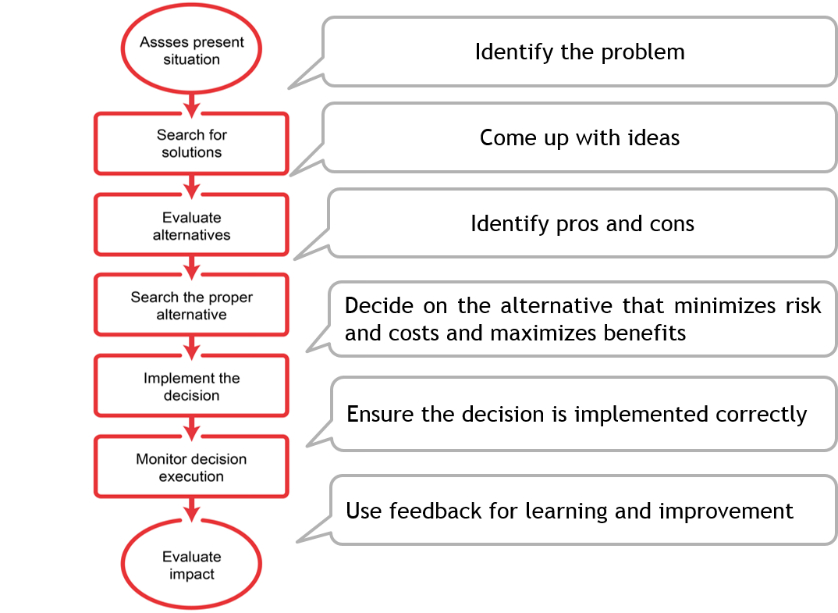How to improve your decision-making process? Part II

In Part I of this article, we emphasized the need to base decisions on data, as this leads to improved results. In what follows next, we will discuss about the steps that need to be taken in the decision-making process and the particularities of making decisions in specific scenarios.
In the graph below, the 7 steps that need to be taken, so as to ensure the proper decisions were made, are presented in the image below.
Graph 1: The 7-step decision-making process

The first step is to assess the present situation, in order to identify the problem. Then, you need to search for solutions and come up with ideas. Once you have identified several solutions, you have to evaluate alternatives and find pros and cons for each solution. In order to choose the proper alternative, you have to decide which one minimizes risk and costs and maximizes benefits. The next step is to implement the decision and to monitor decision execution, to ensure the decision is implemented as agreed. The last step that needs to be taken is to evaluate the impact, which means assessing the results of the implementation, because based on past experience, better decisions can be taken in the future.
What techniques shall we use during the decision-making process to ensure that the proposed solutions are the relevant ones? In the next paragraphs, the most commonly used techniques are presented in order to enhance their understanding and usage in practice:
- Brainstorming – Used to increase creativity and generate as many ideas as possible. Its benefit is that the entire group participates. Ideas are not criticized, as the focus is on the idea, and not on the person who generated it. Once all ideas are noted down and discussed, combination of ideas may turn other people’s ideas into better ideas, or two or more ideas can be joined into one.
- Affinity Diagram – Used to structure the decision-making process. Besides stimulating creativity, this technique also clusters ideas into logical items, based on which decisions are easier to make. Group members usually post their ideas using post-it notes on walls, and then, based on the relationship that exists between ideas, they are clustered under relevant labels. The formed diagram provides a graphical representation of the ideas, which is helpful in the decision-making process.
- Force field analysis – Used to analyze driving and restraining forces in a given situation in order to have an overview of the decision’s pros and cons. Group members list all factors (forces) for and against the decision (resources needed in terms of money, time and people, easiness to implement, support in implementation, benefits, risks, etc.) and then, they assign scores to each of them, based on their importance/influence. In the end, they add up the scores for and against the decision and in this way, the decision is easier to make.
- Flow chart – Used to identify for each idea the steps that need to be taken in order to implement it. The benefit of this technique is that it is logical (it has a starting and an ending point), structured (clear tasks that have to be done) and oriented towards problem solving.
- Planning matrix – Used to analyze the actions to be taken, the responsible persons to ensure their completion, the deadlines for completion and the necessary resources to achieve them.
- Unilateral decision making – Used when decisions need to be made immediately, and there is no time for further analysis and meetings. In this case, the decision is based on the background, knowledge, experience and intuition of the person who makes the decision.
- Consultative/participative decision making – Used when a person makes a decision with contribution from the other group members. It allows everyone’s perspective to be presented and in the end, only one person takes the decision, to be time-efficient.
- Consensus decision making – Used to allow all group members to freely express their ideas. This technique involves debating and negotiation among members.
- Voting decision making – Used in large groups for the effectiveness of the decision-making process. The decision is made by the groups’ majority, not necessarily based on a rigorous analysis.
Having this variety of techniques that can be used in the decision-making process, what needs to be kept in mind is not to use them all, but to choose the most relevant ones in given situations. Combination of techniques is recommended to ensure proper decisions will be made. The next question that arises is how do we adopt decisions in different scenarios? Is the process the same? Do we use the same techniques? Find the answer in Part III of this article.
This article is based on the information available in the Certified Performance Improvement Professional training course offered by The KPI Institute. To find out more about the course and sign up, visit the course description page.
Image source:

Tags: Decision making, Strategy





